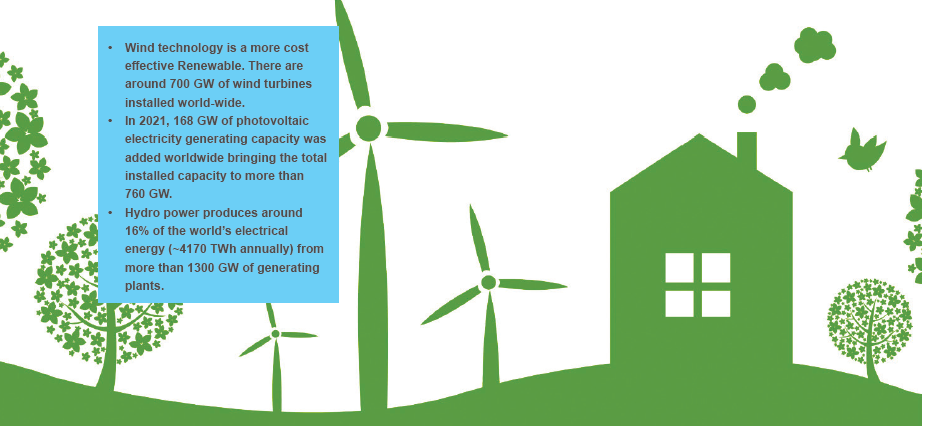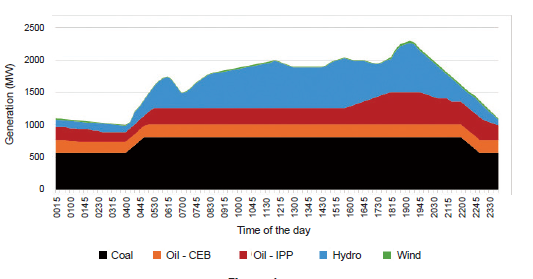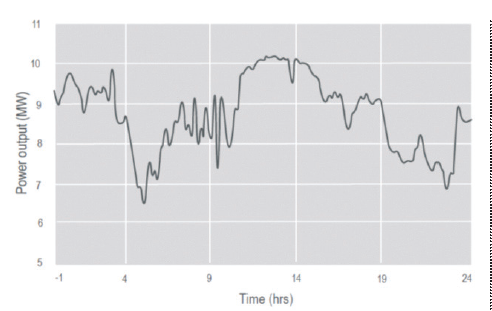Can we be heading towards a Renewable energy future?
What are renewable energy sources?
Renewable energy sources are inexhaustible energy sources that do not produce Green House Gasses. Established technologies include wind power, hydro, solar photovoltaic systems, landfill gas, energy from municipal waste, biomass and geothermal generation. Emerging technologies include tidal stream, wave-power and solar thermal generation.

Wind technology is a more cost effective Renewable. There are around 700 GW of wind turbines installed world-wide. The power output of a wind turbine is proportional to the cube of wind speed until it reaches the rated output. As the wind speed varies naturally with the time of the day, the season, and the height of the turbine from the ground, power output also varies accordingly. The advantages of wind energy generation are: each wind turbine is comparatively large (up to 5 MW onshore and up to 10 MW offshore). Once planning permission is obtained, wind farms can be constructed quickly, and in high wind speed sites it is economical. According to the renewable energy master plan published in 2014 through an ADB project, exploitable wind potential in the country is around 5600 MW.
Energy from the sun strikes the earth as packets of light energy, termed photons. There are two main methods of converting sunlight into electricity. Heat in sun light can produce and drive a steam turbine to produce electricity. However, the most common technique is direct conversion of solar energy into electricity, called Photovoltaic energy (PV). In 2021, 168 GW of photovoltaic electricity generating capacity was added worldwide bringing the total installed capacity to more than 760 GW. According to the renewable energy master plan, if 5% of the area under scrub lands in Northern, Eastern and Uva provinces are utilized for ground mounted solar panels, they would result in about 3000-6000 MW of installed solar PV capacity. Considering possible roof-top and ground mounted solar plants, it is estimated that about 2500 MW will be added to our national grid by 2030. Further, many floating solar plants are identified, and feasibility studies are being carried out.
Hydro power produces around 16% of the world’s electrical energy (~4170 TWh annually) from more than 1300 GW of generating plants. The power that can be generated from a hydro power scheme depends on the flow of water and the height through which the water falls. In Sri Lanka, viable large hydro power potential is almost harnessed and will saturate at 1608 MW from 2025 onwards. According to the renewable energy master plan, 850 MW exploitable small hydro schemes are available and about 500 MW will be harnessed by 2030.
Bioenergy broadly describes all forms of energy resulting from converting biomass, either directly into heat by burning or converting into bio-fuels. Many of the other renewable energy technologies, once the equipment is manufactured and installed, generate electricity with no Green House Gas emissions. With bioenergy, the CO2 that is absorbed from the atmosphere in photosynthesis is subsequently released when the biomass provides useful energy. The process can then be said to be CO2 neutral. Although bioenergy is a concentrated form of solar energy, it does not depend on the instantaneous irradiance of the sun. According to the Renewable energy master plan about 2400 MW bioenergy potential is available in the country but their uptake is relatively slow.
technologies, once the equipment is manufactured and installed, generate electricity with no Green House Gas emissions. With bioenergy, the CO2 that is absorbed from the atmosphere in photosynthesis is subsequently released when the biomass provides useful energy. The process can then be said to be CO2 neutral. Although bioenergy is a concentrated form of solar energy, it does not depend on the instantaneous irradiance of the sun. According to the Renewable energy master plan about 2400 MW bioenergy potential is available in the country but their uptake is relatively slow.
How is the power system currently operated?
Modern electrical power systems generate power with ratings up to 1000 MW driven by high-pressure steam from fossil fuel boilers and nuclear reactors or by hydro power. The electrical power is fed through generator transformers to a high voltage interconnected transmission network, known as a grid. The transmission system is used to transport the bulk electrical power, sometimes over considerable distances, and it is then extracted and passed down through a series of distribution transformers to radial distribution circuits for delivery to the customers.

The generating units are mainly synchronous machines. Synchronous generators are analogous to a dancing group who does Zumba or acrobatic dancing. These dancers are following their steps tuned to a music that are at different frequencies. All the synchronous generators connected to the grid (irrespective of their location) are tuned to 50 Hz frequency and act together, as dancers in a dancing group, for any changes in the grid frequency. At any given time, the total power generated by the synchronous generators are equal to the total load connected, thus the grid operates at 50 Hz. If there is an imbalance between generation and load demand, that will reflect on the system frequency. In terms of frequency, an electric power system can be viewed simply as a single rotating mass of equivalent inertia. All the turbine generators and spinning loads operate as a single coherent generator with one rotational speed and a single system frequency. The equivalent inertia is the sum of the inertias of all the turbines and generator rotors that are connected to the power system. This inertia plays a vital role when keeping the frequency within its operational limits, especially under contingencies.
Even in a power system without a significant proportion of renewable generation, mismatches between the scheduled generation and demand are inevitable. These are due to variations in customer demand, sudden connection or disconnection of large loads, sudden loss of part of the transmission network due to a fault, and sudden loss of a large generator. Any mismatch between the generation and load results in a frequency change that is compensated initially by the kinetic energy of rotating generators. Minor mismatches between customer demand and generation are compensated automatically by the action of the governors of large generators.
Significant mismatches between demand and generation caused by a sudden loss of generation or a large part of the customer load may cause large changes in frequency. In order to control the frequency change, different automatic frequency response services are used by the system operator. These include response, reserve, and load shedding. If the mismatch cannot be arrested with these automatic measures, the power system will become unstable resulting in a partial or complete blackout.
How does the power system operation change with more renewables?
Increasing the output power of large steam generators is possible, using the heat energy stored in the boilers and, more slowly, by burning more fuel. Hydro units with reservoirs to store water can also vary their output as the system frequency changes. Renewable energy generators do not have these energy stores and so do not take part in the control of power system frequency. Rather, they inject energy into the electrical power system as the renewable energy resource is available.
When renewable energy generators are connected to the system, they displace conventional power plants and the system inertia drops resulting in more rapid frequency excursions for changes in generation or load. This reduction in the inertia of the power system caused by increasing operation of renewable generators is a major topical concern of power system operators.
When renewable generators are in operation, mismatches between generation and loads are also caused by the variability of the generation. The following figure (Figure 2) shows the variation of the power output of a 10 MW wind power plant connected to our network over one day. As can be seen, a rapid variation of the wind power is experienced over the day. The stability of the conventional power system is provided by the large synchronous generators. As discussed before, these units adjust their output to ensure there is a balance between system demand and supply at all times. They also provide the majority of the system inertia. Most renewable generators do not take part in the balancing of the system but merely supply energy from the wind or sun when the resource is available. These renewable generators can only operate when there is a strong voltage and frequency reference provided by the large synchronous generators.
It is clear that operating renewable generators as sources of energy only and relying on the large synchronous generators to provide all the control and stability of the power system is only satisfactory when there is a modest fraction of generation from renewable sources. As more and more renewable generation is connected to the power system, this simple way of operation will have to change and the renewable generators must evolve to contribute fully to the control and stability of the power system.
What are the changes required to operate a Power System with a large penetration of renewables?
As discussed in previous sections, the variation and intermittency of the power output of conventional renewable energy generators cause operational difficulties and incur additional costs to Grid operators and finally to electricity consumers. A Grid Operator (such as CEB) is responsible to maintain uninterrupted power supply at a reasonable tariff with defined parameters in power quality. With the rapid involvement of technology (Artificial Intelligence, IOT, Industry 4 etc.) the quality of power has inevitably become a customer demand. At present the operational difficulties caused by intermittency and variability of the renewable generators are countered and managed by connecting into a large power system, where renewable generators benefit from the diversity of the loads, the inertia of main generators, and the stored energy in the fossil fuel of conventional generators. In some cases, in order to maintain power system stability, certain selected large fossil fuel generators are operating in standby mode.
In principle, an energy storage device can be installed along with a renewable generator to smooth the output or to store energy, so as to supply energy when the renewable resource is not available. To provide long-term energy storage, options like batteries, fuel cells, or pumped hydro could be used. Worldwide, there have been number of examples of the demonstration of energy storage system with a renewable generator. For example, a NaS battery system of 245 MWh, 34 MW has been installed at the 51 MW Rokkasho wind farm in Japan to smooth the wind power output and to allow the wind farm to supply demand according to a defined schedule. In Southern Australia, there is a growing interest in installing Li-ion batteries with large PV farms to store energy when the local load (demand) is low and release the stored energy as and when needed. For example, a 200 MW Solar River plant will be coupled with a 100 MW/300 MWh storage system.
It would appear to be desirable to install an energy storage device with every renewable generator, but this is not common practice. The initial capital cost of energy storage devices remains high and the maximum achievable overall efficiency of storing and retrieving electrical energy is only around 80%. However, prices of the energy storages are coming down rapidly and many applications with practical solutions are emerging. This will enable power grid operators to absorb a higher proportion of renewable energy sources.
For a country like Sri Lanka, pump hydro is one of the viable energy storage options. These schemes have two reservoirs, one at a higher elevation than the generator-pump station and the other at a lower elevation. During the time solar or wind generation is high, water can be pumped from the lower reservoir to the higher reservoir. In the peak hours, the water stored in the higher reservoir can be used for power generation.
Intelligently controlled active networks that facilitate the integration of renewable generation into the power system are also being considered widely. There are a range of enabling technologies such as information and communications technologies; sensing, measurement, control and automation technologies; power electronics; and advanced components and materials that facilitate intelligently controlled active networks. The name smart grid has become common to describe the future power network that will make extensive use of the above-mentioned technologies to support a flexible, secure and cost-effective de-carbonised electrical power system.
A de-carbonised electrical power system supplied from renewable energy sources and generators with steady power output (perhaps nuclear and fossil plant with Carbon Capture and Storage), needs greater involvement and status of customer end load in its pattern of operation. Hence the concept of ‘Demand Side Participation’ has emerged in power grids worldwide. Demand Side Participation is a potential means of increasing flexibility and controllability in the power system. Controllable loads such as charging electric vehicles will allow increased utilisation of renewable energy effectively. More radically, it is anticipated that the battery energy storage of electric vehicles may be used to inject power into a localized grid at times to replace part of high cost power generation and to facilitate islanded operation of distribution electrical networks. The role of smart metering and how the customers will wish to control their loads at a given time and their willingness to take part in the operation of a power system is an important topic and there are studies and investigations with trials being undertaken currently in many countries. As discussed here, there are a number of options available for a utility to bring its network towards a decarbonized network with the absorption of higher proportion of renewables. However, it is important to consider the following points before deployment of largescale renewables.
Identification and evaluation of standard operational philosophy, processes, practices and control room tools.
Development of dynamic scheduling systems to accommodate system changes arising due to variable renewable energy sources.
Development of energy storage solutions to overcome intermittency and variability of renewable energy sources. In this regard, the immediate implementation of possible pump-hydro schemes is important.
Development of technical solutions and methods to overcome decrease in system inertia with the higher penetration of renewables.
Development of grid connection codes that demand asynchronous generators associated with renewable energy sources to match the contributions (technical nature) offered by typical synchronous generators.
Committed plan to accommodate renewables in structured development phases along with technology advancement.
Establish a regulatory policy on electricity tariff and incentives that enables demand side participation and empowerment.
More importantly, continuous research and development activities with the involvement of utility, network operators, economics, technical solution providers, academics, and researchers should be considered to take our power grid towards a decarbonised and sustainable smart grid.
In principle an energy storage device can be installed along with a renewable generator to smooth the output or to store energy so as to supply energy when renewable resource is not available. To provide long-term energy storage options like batteries, fuel cells, or pumped hydro could be used. Worldwide, there have been number of examples of the demonstration of energy storage
40-8



